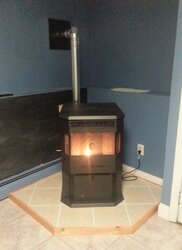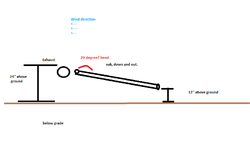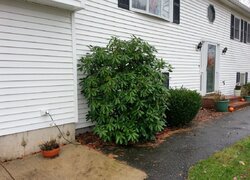OK so planning on installing my OAK soon. See pic below. The wall on the right has the inside of my garage on the other side. I have seen the combination exhaust / intake thimble before. Was thinking of drilling a hole in my existing thimble and running my OAK through there. Wondering how in that configuration you keep the OAK from sucking in exhaust? I guess my other option would be to run the OAK vent along the wall to the left until I get far enough away from my exhaust. Note that the bottom half of the wall is my foundation under the drywall. Any placement/install suggestions would be much appreciated!!
OAK Placement Suggestions?
- Thread starter StormPanic
- Start date
-
Active since 1995, Hearth.com is THE place on the internet for free information and advice about wood stoves, pellet stoves and other energy saving equipment.
We strive to provide opinions, articles, discussions and history related to Hearth Products and in a more general sense, energy issues.
We promote the EFFICIENT, RESPONSIBLE, CLEAN and SAFE use of all fuels, whether renewable or fossil.
You are using an out of date browser. It may not display this or other websites correctly.
You should upgrade or use an alternative browser.
You should upgrade or use an alternative browser.
- Status
- Not open for further replies.
I'd say a couple of things have to be considered if you plan on going thru the thimble cover...
1. How far out from the wall is your cap? If you meet code for your unit, & run the OAK so that it barely penetrates the wall, you probably won't draw in any exhaust.
2. Can you keep the OAK on the lower side of the exhaust? Hot air will rise after it exits the cap, so a lower OAK intake will draw cooler air in.
3. Which way does the wind blow? Does it blow DIRECTLY at the wall where the vent exits? That might cause some exhaust to get directed to the intake, no matter where it's located...
You DEFINITELY do NOT want your OAK drawing from the garage. You don't want ANY flammable fumes getting drawn into the burnpot...
1. How far out from the wall is your cap? If you meet code for your unit, & run the OAK so that it barely penetrates the wall, you probably won't draw in any exhaust.
2. Can you keep the OAK on the lower side of the exhaust? Hot air will rise after it exits the cap, so a lower OAK intake will draw cooler air in.
3. Which way does the wind blow? Does it blow DIRECTLY at the wall where the vent exits? That might cause some exhaust to get directed to the intake, no matter where it's located...
You DEFINITELY do NOT want your OAK drawing from the garage. You don't want ANY flammable fumes getting drawn into the burnpot...
My exhaust pipe goes straight out the wall 12" and then there is the standard pelletvent hood which exhausts down.
My exhaust pipe goes straight out the wall 12" and then there is the standard pelletvent hood which exhausts down.
Then I'd say you could run the OAK thru the thimble cover above or below the pellet vent, depending on the prevailing wind... The Harman thimble with the OAK has the intake just above the vent pipe.
Would there be any problem running the OAK pipe up the exhaust pipe and clamping them together, simply for aesthetics?
jtakeman
Minister of Fire
I checked the Regency manual for recommendations on the OAK. They didn't list much. Because this stove is a clone of the Enviro Meridian you could use the info for that. See PDF.
I is what I would go by for the inlet air. Distence should be 3 feet minimum from the vent outlet. I would also favor it to be below the vent outlet. But high enough off the ground to avoid snow covering it.
I is what I would go by for the inlet air. Distence should be 3 feet minimum from the vent outlet. I would also favor it to be below the vent outlet. But high enough off the ground to avoid snow covering it.
Attachments
SmokeyTheBear
Minister of Fire
You want that OAK termination below and to side of the vent termination, that way it gets it out of any pellet stove exhaust issues including winds, and allows a decent vertical separation to maintain a natural draft in the vent system so a power failure doesn't result in smoke in the house.
OAKs need their termination outside of any building shell. No ifs, ands, buts, or maybes.
ETA: Much more detailed information for installing a GF55 is here:
https://www.google.com/url?sa=t&rct...LZgYAO&usg=AFQjCNEMF_rQxOQym3CzGD7Nbh35ifBPUQ
OAKs need their termination outside of any building shell. No ifs, ands, buts, or maybes.
ETA: Much more detailed information for installing a GF55 is here:
https://www.google.com/url?sa=t&rct...LZgYAO&usg=AFQjCNEMF_rQxOQym3CzGD7Nbh35ifBPUQ
briansol
Minister of Fire
My manual calls for 4' below the exhaust end. I imagine, a hook to the left and down a bit will work too.
My manual calls for 4' below the exhaust end. I imagine, a hook to the left and down a bit will work too.
So in that case, running the OAK through the existing thimble would be no good correct? Would there be any problem with a long run of OAK pipe (say more than 10')?
SmokeyTheBear
Minister of Fire
So in that case, running the OAK through the existing thimble would be no good correct? Would there be any problem with a long run of OAK pipe (say more than 10')?
It depends upon what the vent is like outside the house.
You need to keep all venting runs (that includes OAKs) to as short and as bend free as possible.
In your case you have to be above grade and below the vent termination.
The distance from the vent termination has to be by 12" according to the manual.
Above ground has to be so leaves and snow can not interfere with it.
We really need to see the outside to place things.
It depends upon what the vent is like outside the house.
You need to keep all venting (that includes OAKs to a short and as bend free as possible).
In your case you have to be above grade and below the vent termination.
The distance from the vent termination has to be by 12" according to the manual.
Above ground has to be so leaves and snow can not interfere with it.
We really need to see the outside to place things.
Sorry - don't have pics of the outside. Basically the pipe goes straight out of the house around 16" and terminates with the Pelletvent standard hood. There is no vertical piping outside the house. The pipe is 24" above the ground. There is no grass below, only crushed stone. Will take a pic when I get home later.
briansol
Minister of Fire
this may not be up to code, or work-- just a suggestion. I would put the intake UP WIND and down and out from the thimble so that you get the distance and still maintain some clearance above grade.
If it snows, clear it out. A foot storm is rare.... at least before you can get out there with a shovel to make sure its clear. That will give you the distance you want.
Might be a little ugly, but you can work something.
If it snows, clear it out. A foot storm is rare.... at least before you can get out there with a shovel to make sure its clear. That will give you the distance you want.
Might be a little ugly, but you can work something.
Attachments
SmokeyTheBear
Minister of Fire
I have a basement install, my OAK exits just above the half wall + rim joist and 9" to the right and 24" below the vent (viewed from the inside). This places my OAK 26" from the ground outside.
I have started a smudge fire in the stove and the smoke all exits the venting. also we have had a couple of power failures (one a short fluctuation that the stove sailed through and kept running afterwards) while the stove was running and no smoke in the house.
Just so you understand we aren't trying to make life difficult by hammering on this stuff, just safe.
Jay does that manual some what jibe with the Milan one?
I have started a smudge fire in the stove and the smoke all exits the venting. also we have had a couple of power failures (one a short fluctuation that the stove sailed through and kept running afterwards) while the stove was running and no smoke in the house.
Just so you understand we aren't trying to make life difficult by hammering on this stuff, just safe.
Jay does that manual some what jibe with the Milan one?
I have a basement install, my OAK exits just above the half wall + rim joist and 9" to the right and 24" below the vent (viewed from the inside). This places my OAK 26" from the ground outside.
I have started a smudge fire in the stove and the smoke all exits the venting. also we have had a couple of power failures (one a short fluctuation that the stove sailed through and kept running afterwards) while the stove was running and no smoke in the house.
Just so you understand we aren't trying to make life difficult by hammering on this stuff, just safe.
Jay does that manual some what jibe with the Milan one?
Totally understand - just want to do this right (and only once). The corner install in the basement next to the garage limits my options a bit.
SmokeyTheBear
Minister of Fire
I have mine in a corner and there is a deck that runs the length of the house on the outside at the second floor level where you are indicating your garage is so I understand limitations.
The other corners are under the ground level or would put things into well for lack of a better words the inside stairwell and a garage and those would be huge mistooks.
The other corners are under the ground level or would put things into well for lack of a better words the inside stairwell and a garage and those would be huge mistooks.
I am thinking I am going to need to go along the lower wall to the left around 5 or 6 feet, and then up and out the front wall. Not going to be pretty.
Wondering how hard it would be to hide it in the wall? Guess it depends on how much drywall patching I want to do.
SmokeyTheBear
Minister of Fire
I am thinking I am going to need to go along the lower wall to the left around 5 or 6 feet, and then up and out the front wall. Not going to be pretty.
Why?
Why?
There is a window you can't see to the left of the stove (4' from the exhaust pipe per reqmts). I need to get on the other side of that I guess. Really wish I could just go through the thimble.
briansol
Minister of Fire
Harvey Schneider
Minister of Fire
I don't think that is a good idea. Air intake cannot stand high temperatures. If you have a backfire, there could be leakage into the wall. You won't know about it until the fire breaks out.Wondering how hard it would be to hide it in the wall? Guess it depends on how much drywall patching I want to do.
You can. Just run it the length outside.
That would be pretty ugly, though. My vent is on the front of my house, the vent pipe is hidden behind a bush (with sufficient clearance).
briansol
Minister of Fire
"* Landscape with fire-resistant tree and shrub species like walter's viburnum, beautyberry, coontie, red maple, oaks, and magnolia. Native magnolia species like sweetbay magnolia (Magnolia virginiana) are well adapted to Southwest Florida's sands. The public can visit Naida's Native Plant Garden at the Southwest Florida Horticulture Learning Center at 14700 Immokalee Road to see other examples of nonflammable native shrubs and trees"
Just saw that on a search for preventing forrest fires. heh
Just saw that on a search for preventing forrest fires. heh
SmokeyTheBear
Minister of Fire
There is a window you can't see to the left of the stove (4' from the exhaust pipe per reqmts). I need to get on the other side of that I guess. Really wish I could just go through the thimble.
So that doesn't prevent an OAK termination there at all.
What is to the right facing that thimble from inside the house?
OK here is a view of the outside before I put in the stove. The vent pipe comes out of the house directly behind this bush which has since been significantly downsized to make way for the pipe. The inside corner to the left of the bush is the corner my stove is in. The wall sticking out to the left is my garage. Hope this helps. Was thinking of possibly running the pipe into the garage but coming out of the garage somewhere near the electric outlet??
Attachments
- Status
- Not open for further replies.
Similar threads
- Replies
- 2
- Views
- 827
- Replies
- 6
- Views
- 866
- Replies
- 1
- Views
- 499
- Replies
- 10
- Views
- 720




